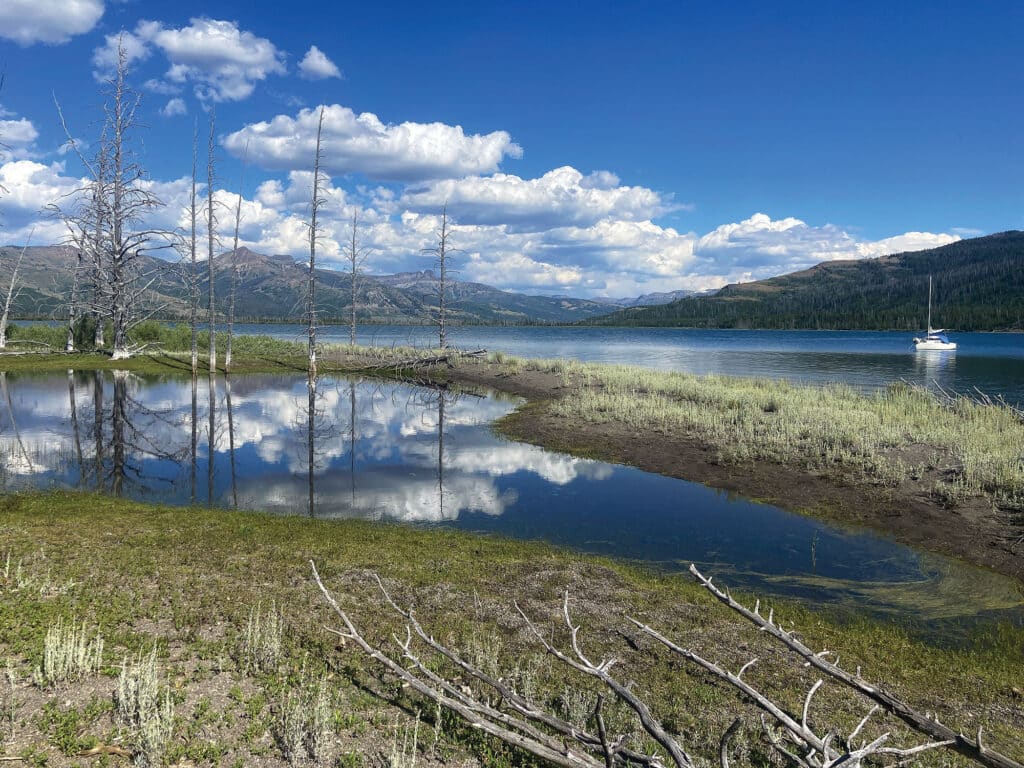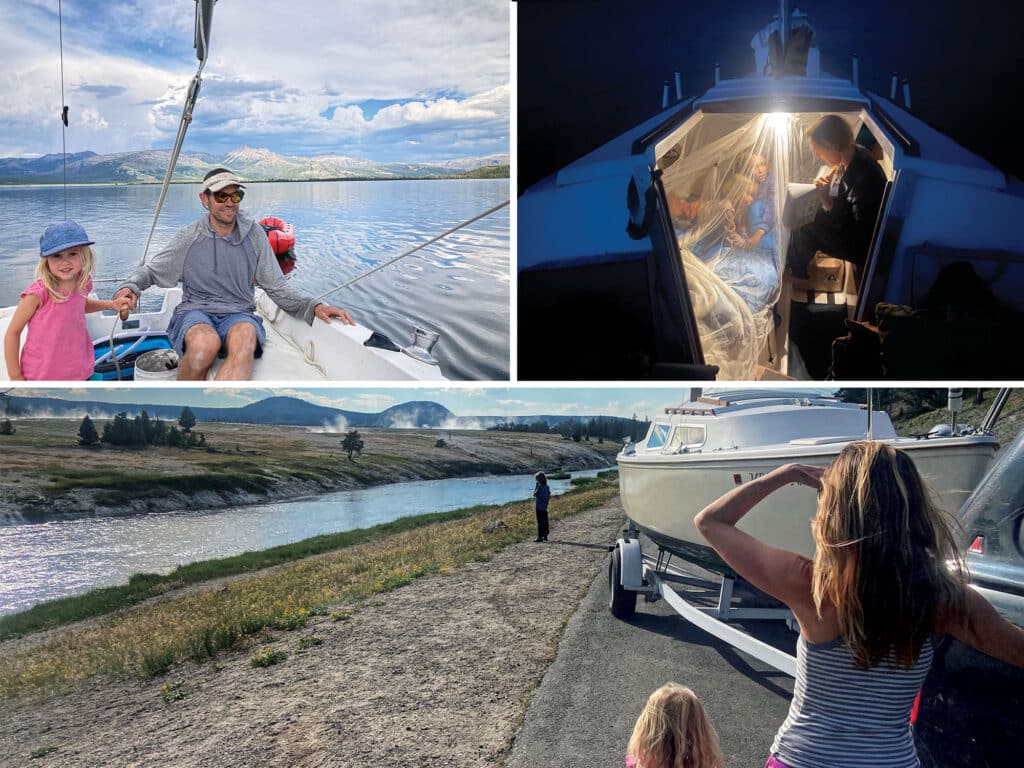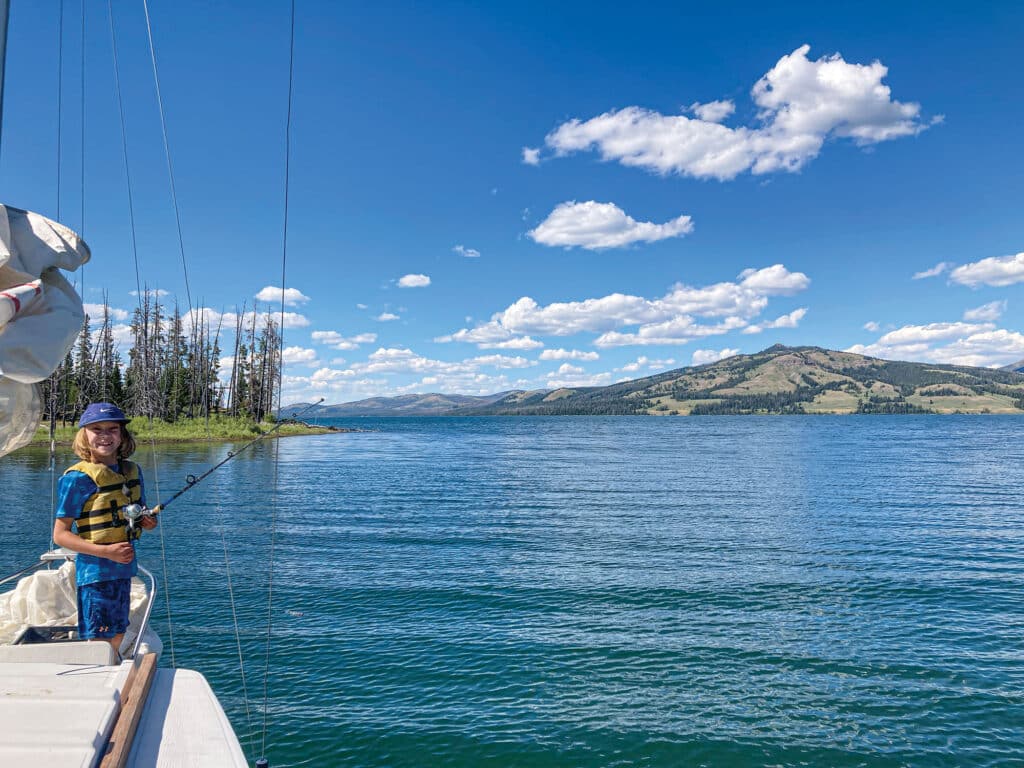
Smells like dinosaur poop,” Lyra said, wrinkling her 4-year-old nose as we stepped out of our dinghy onto the delta of the Yellowstone River. “Mom, look! A dino footprint!”
She wasn’t far off the mark. Great blue heron tracks traversed the mile-long mudflat, the pterodactyl-like claw prints bigger than Lyra’s hand. She skipped ahead to join her brother, who was collecting a bouquet of windblown osprey feathers to bring back to our boat. My husband, Rob, set out to stalk the shoreline with his fly rod, hoping to pull in yet another hefty Yellowstone cutthroat trout.
I surveyed the wild scenery: The 11,000-foot-tall Table Mountain rose just behind a dense swath of green willows, with nary a trace of human life in sight. Behind me, our 1974 Catalina 22, Tranquilidad, gleamed atop a vast navy lake, the only boat for miles. We were anchored where the Yellowstone River empties into its namesake lake in one of the most remote parts of Yellowstone National Park. Nicknamed “the Thorofare” because it’s a major migratory corridor for animals such as elk, deer, bison, wolves and grizzlies, this area includes the farthest point from a road in the Lower 48—which was about a dozen miles upriver from where we were anchored. Fewer than 100 people visit the Thorofare each year; all of them have to move through it by foot, paddle or wind power.
Arriving at this rewarding destination was definitely not simple. Our journey began three years prior, when we found an affordable swing-keel boat and trailer that looked perfect for fulfilling our dream of sailing across Yellowstone Lake.
The only trouble was that the keel was inside the cockpit instead of attached to the hull. After renting a mini excavator to lift the 600-pound cast-iron fin, building a wooden contraption to slide it under the boat, and then replacing the cable and winch, we were in business. We took Tranquilidad out on a small lake near our home in Missoula, Montana, to test whether it leaked, what needed replacing, and how to stow gear, food and four bodies in a space barely bigger than our couch.
Our first overnight lake voyage proved that we’d need to wait on Yellowstone until our kids were older. At barely 1 year old, Lyra was a definite liability on deck. And while 5-year-old Talon was slightly more capable, he was way more interested in endlessly casting bobbers off the bow than sitting still in the cockpit.
Two years later, after a dozen more weekend trips and plenty of patching, painting, and reconfiguring the boat, we deemed the family and Tranquilidad ready to traverse the largest high-elevation lake in North America.
First, though, we had to navigate the National Park Service permitting system. Our plan was to launch at Grant Marina, one of two marinas on the lake, then head toward the delta of the Yellowstone River 30 miles southeast. We hoped to camp at least one night each way to break up the sailing time for the kids and to explore other parts of the lake.
The backcountry rules for camping or boating on Yellowstone Lake cover an entire 20-page booklet, which we pored over (literally with a magnifying glass) in March. Some sites are off-limits certain dates for waterfowl nesting. Some require boats to be completely removed from the water, an obvious no-go for us. We researched wind patterns and calculated mileages, then mailed in a list of desired anchorages, dates and backup choices, only to find out that the National Park Service had just changed to an online system for backcountry permits.

A couple of months later, we received an email that we were approved for the early lottery and had earned a chance to reserve our sites. Next up, we turned our attention to the trailer.
Hauling a sailboat 320 miles over mountain passes and along winding two-lane roads would arguably be the most nerve-wracking part of the whole trip. Rob greased bearings, replaced the aging tires, and made sure a spare was accessible.
Then we created meal plans and shopping lists to outfit our family for seven days of camping. We also double-checked our safety gear, some of which was required: a handheld VHF radio (since Tranquilidad has no electrical wiring), life jackets, throw ropes, battery-powered navigation lights, a foghorn, flares and bear spray.
On a hot July morning, we departed for Yellowstone, our truck packed with bedding and clothes, food and water, books and games, and gear for fishing, snorkeling and hiking. We made sure to arrive at the park entrance in the evening, in hopes of avoiding long lines of summer tourists who drive at a snail’s speed.
Our plan worked: Hundreds of cars streamed past us, exiting Yellowstone as we cruised in. The kids pointed at bison lumbering along the road and elk grazing in green meadows. We even got lucky as we arrived at Old Faithful, pulling into the parking lot just as the geyser began erupting. “A water volcano! Run, Mom, run!” Lyra yelled, pulling me toward the geothermal wonder as soon as she hopped down from the truck.
That night, we set up a tent at Grant Village Campground because we couldn’t launch Tranquilidad without park officials first inspecting the vessel for aquatic invasive species. The next morning, we arrived at the park’s backcountry office promptly at 8 for our inspection, and to gather our permits and watch the mandatory video on wilderness safety.
As Rob and I raised the mast and readied the sailboat in the marina’s parking lot, the kids practiced the video’s top recommendation for avoiding bear encounters: Make lots of noise.
We were underway by 10, a light breeze behind us. The southeast arm where we were headed was nonmotorized, but we’d mounted a 3 hp outboard in case we needed propulsion on other parts of the lake. Our cherry-red Alpacka Forager bounced on its painter in our wake. We used this versatile, 13-pound inflatable raft as a dinghy.
Four hours and 17 miles later, we made it to our first anchorage. Nesting loons called from a sandy spit, and lodgepole pines sent shadows into the shallows. Rob and Talon fished from shore for cutthroat that were rising amid a thick hatch of mayflies while Lyra and I made a sandcastle crowned with an enormous rack of elk antlers we found in the woods. We even swam a bit, surprised that the water wasn’t as frigid as expected. All 132 square miles of Yellowstone Lake freeze each winter—some parts had thawed mere weeks before we arrived. At 7,733 feet above sea level, the average year-round water temperature is 41 degrees Fahrenheit.
I’ve sailed across the Pacific and lived under Montana’s big skies for 20 years, but I’ve never seen stars as dense and as crisp as from atop Yellowstone Lake.
In fact, even though it was midsummer, I’d packed our wool socks, down coats and winter hats. Yellowstone is infamous not only for its cold water, but also for its unpredictable mountain weather. A friend who had sailed across Yellowstone a decade ago warned us: “Watch out for squalls. Waves whip up fast out there.”
But our trip was plagued by the opposite problem: no wind. We’d launched during a heat wave, which left us bobbing slowly beneath scorching sun. Fortunately, Tranquilidad was able to ghost along at 2 knots even when the surface was glassy—a boon because the outboard (which had served us well the past two years) had lost power. We’d forgotten to account for the fact that its tiny carburetor was getting less oxygen at the lake’s high elevation. In between maximizing sail trim in the scanty breeze, we fiddled with a system of tarps and umbrellas to create patches of shade. Although we’ve weathered plenty of harrowing gales at sea and backpacked dozens of miles through the wilderness together, Rob declared Day Three “one of our hardest adventure days yet.” He’d take 30-knot winds and stormy waters almost any day over inching along beneath 90-degree sun.
The plus side of going slowly was that we had plenty of time to fish from the boat and to watch the jaw-dropping scenery. Yellowstone’s forests are immense. The water is cold and clear. The flower-filled meadows are magical. And all of it we had nearly to ourselves. Over the course of seven days, we saw fewer than a dozen motorboats and only a handful of canoes and kayaks.
When the sun finally set after 9 each evening, we all breathed a sigh of relief—until the mosquitoes and biting flies found us. They seemed to particularly like the cabin, congregating in every corner below to nip at ankles and elbows. We rigged a mosquito net over the kids’ berth while Rob and I each bunked on one of the narrow cockpit benches, pulling our hats low and sleeping bags high.

Sleeping outside was well worth a few bug bites to gape at the stars though. I’ve sailed across the Pacific, camped in Alaska, and lived under Montana’s big skies for 20 years, but I’ve never seen stars as dense or as crisp as from atop Yellowstone Lake. It gave “milky” a new meaning as our galaxy glittered above.
We spent a lovely few days hiking around the Thorofare. Talon chased frogs and caught butterflies. Lyra plundered patches of fingernail-size strawberries. Rob and I took turns snorkeling from the boat, stalking thickets of logs stacked underwater in search of the lake’s namesake cutthroat trout. All of us competed in stone-skipping competitions from the gravel beaches, counting the pings each rock made across the clear green water. While we spotted a few deer grazing on the shore and all sorts of shorebirds, waterfowl and raptors, we never ran across any of Yellowstone’s famed megafauna. The intense heat surely relegated most animals to nocturnal ambles. We did, however, witness a few extraordinary hatches of mayflies—aquatic insects that feed fish and birds. One morning, they coated every lee surface of the boat and our bodies for an hour, thousands of tiny U-shaped creatures with fluttering, gossamer wings.
On Day Five, when we were slated to move to a new campsite a few miles northwest, we waited until the wind picked up in the evening. As we tacked back and forth on a close reach, thunderheads built over the mountains and spread purple across the western horizon. Mounting waves were beginning to rock Tranquilidad. I glanced at the wide-open shoreline along our designated anchorage and realized that we would be exposed to the full fetch of the lake.
As we sailed closer to our intended anchorage, Rob pointed out a small stream, about 8 feet across, that connected to an interior pond just off the main lake. It looked invitingly calm, protected by a ring of pine trees. I set the anchor and lashed the sails, our rigging rattling in the building storm, while Rob quickly paddled the dinghy over to gauge the stream’s depth. “Two feet, maybe!” he yelled over the wind. With our keel and rudder raised, Tranquilidad drafted just under 2 feet. I motioned him back, calling, “Let’s try it!”
We paddled the sailboat through the small cut, wind at our back, holding our breath. Our bottom didn’t scrape a whit, and we breathed a sigh of relief: We had found a freshwater hurricane hole. Nestled happily in our placid little pond, we dined on ramen noodles while whitecaps frothed in fury across the mighty lake beyond.
As we tacked back and forth on a close reach, thunderheads built over the mountains and spread purple across the western horizon.
The gale dissipated by bedtime, and morning once again dawned hot and breathless. We settled in for a long, slow meander back to the marina. The kids read books and played cards in the tiny cabin. I did yoga on the bow while Rob listened to a podcast under an umbrella at the helm. Even though the breeze was only a faint glimmer, Tranquilidad moved at a respectable 3 knots.
The marina came into sight around 2 p.m. But as soon as we rounded the aptly named Breeze Point, the wind whipped up quickly and aggressively—just like we’d been warned. It circled 180 degrees and blasted across our nose in 35-knot gusts, sending us heeling hard to starboard. We frantically secured our scattered gear and swapped out the genoa for the storm jib. An hour later, after two dozen tacks and a lot of nail biting from our kids, we tied up safely to the dock.
I handed out pepperoni slices and water bottles while we got our land legs under us again. Rob backed the trailer down, and we pulled Tranquilidad out of the water.
As the boat dried beneath the pines in the parking lot, I asked, “Who wants to jump in the lake one last time?” Both kids grabbed their nets and raced to the beach, just in case there were any critters worth catching along the way.
Know Before You Go
Make sure you’re familiar with the extensive regulations and permits required to boat in Yellowstone National Park. These can be found on the national park’s website, along with park-entrance requirements and fees. Here are the highlights.
Season and boat length: The season runs Memorial Day through the end of October. Nonmotorized boats (including sailboats) are allowed on several lakes in the park, including Yellowstone, Lewis and Shoshone lakes. Vessels must be under 40 feet to launch in the park.
Marinas: Grant Marina has a boat ramp, trailer parking and pit toilets, but no slips or overnight moorage. Bridge Bay Marina has overnight slip rentals, but a low bridge to enter might limit sailboats. Both marinas are best accessed from the West Yellowstone entrance in Montana. Expect a one- or two-hour drive through the park (and delays from bison gawkers).
Backcountry reservations: All vessels must have a backcountry permit for a designated campsite each night, even if you sleep aboard your boat at anchor. First, study the map and boating regulations booklet for descriptions of each site (a few even have docks) and the mileage between them to plan your preferred itinerary. Next, apply for a reservation through the early access lottery at recreation.gov in March. If chosen for early access, you will be allotted a two-hour window in April to reserve your itinerary online. Remaining advance permits are available on recreation.gov in late April—and they go fast. A hard copy of the permit must be picked up in person at any backcountry office in the park the day before or the day of your launch date.
Aquatic invasive species: All watercraft must be inspected for aquatic invasive species prior to launch, and are required to have an AIS sticker on the hull after inspection. This can be done at a backcountry office after you pick up your permit.
Fishing license: If you plan to fish, you’ll also need to get a license from the state of Wyoming and a permit from Yellowstone National Park. Be familiar with fishing regulations for each lake.
Wilderness preparation: Don’t expect to see a gas station, restaurant or rescue vehicle once you’re on the lake. Bring plenty of water, fuel, food and tools. It’s also a good idea to bring an extensive first-aid kit, a satellite tracker like Spot or Garmin inReach, and protection from sun, rain, and bugs. Each campsite has a pit toilet, or you can use your boat’s holding tank. You’ll be required to watch a short video on wilderness safety when you pick up your permit before launch.
Required equipment: The park requires all boats to have PFDs, a sound-producing device (like an air horn or whistle), running and navigation lights, fire extinguishers, ventilation, and flame arrestors for inboard engines. Though not required, the park recommends bringing the following safety gear: an oar or paddle, bailing device, anchor and line, VHF radio, compass, GPS unit, dry bags, a floating throw rope or ring, and a visual distress signal such as flares.
Non-motorized or no-go zones: Certain areas have restrictions on speed, motors, anchoring, and/or landing vessels to protect natural resources and nesting waterfowl. Print out the map and boating regulations guide to have these rules on board and to ensure that you follow any special instructions laid out in your permit. Bring along a few field guides and a good set of binoculars to help identify the flora and fauna you’ll see in the park.
Triple-Check Your Trailer
While it might be more fun to focus on rigging your boat for the upcoming adventure, it’s just as important to get your trailer shipshape to ensure that you actually make it to the water. Trailers require constant, careful maintenance to keep you, your boat, and other vehicles safe while on the road.
Avoid flats by inflating trailer tires to their maximum rating, which may be as high as 50 or 60 psi. Check the tread carefully, noting if it’s wearing more on one side, which might mean that the axle is bent.
Flats are fairly common for trailers. Always bring along a good-quality spare tire, either mounted on the trailer or stowed in the back of the truck, along with tools and a jack to change a flat.
Inspect the wheel bearings and repack them with fresh grease (marine grade) every few years or before a long trip.
Check the brake fluid and brake pads on your truck and trailer (some lightweight boat trailers don’t have their own brakes).
Make sure the trailer lights work, including signals, brakes and rear running lights. Clean any rust or mud off the ground-wire connection with sandpaper.
Check that the trailer ball hitch is seated properly before you go. Make sure your safety chains are properly connected, and take it slow. Like sailing, you’ll get there eventually.








